Aspects of Contract and Negligence in Business: A Detailed Report
VerifiedAdded on 2020/01/16
|15
|4116
|137
Report
AI Summary
This report provides a detailed overview of contract law and negligence within a business context. It begins by defining contracts and their essential elements, such as offer, acceptance, consideration, and intent, along with a discussion of different mediums for forming contracts. The report then explores various aspects of contract law, including conditions, warranties, and exemption clauses, and analyzes several case studies to illustrate these concepts. Additionally, it examines the principles of liability for negligence in business activities. The report covers topics like exclusion clauses and implied terms, providing a comprehensive understanding of the legal aspects of business operations. The inclusion of case studies helps to demonstrate the practical application of these legal principles in various business scenarios, making it a valuable resource for students studying business law.
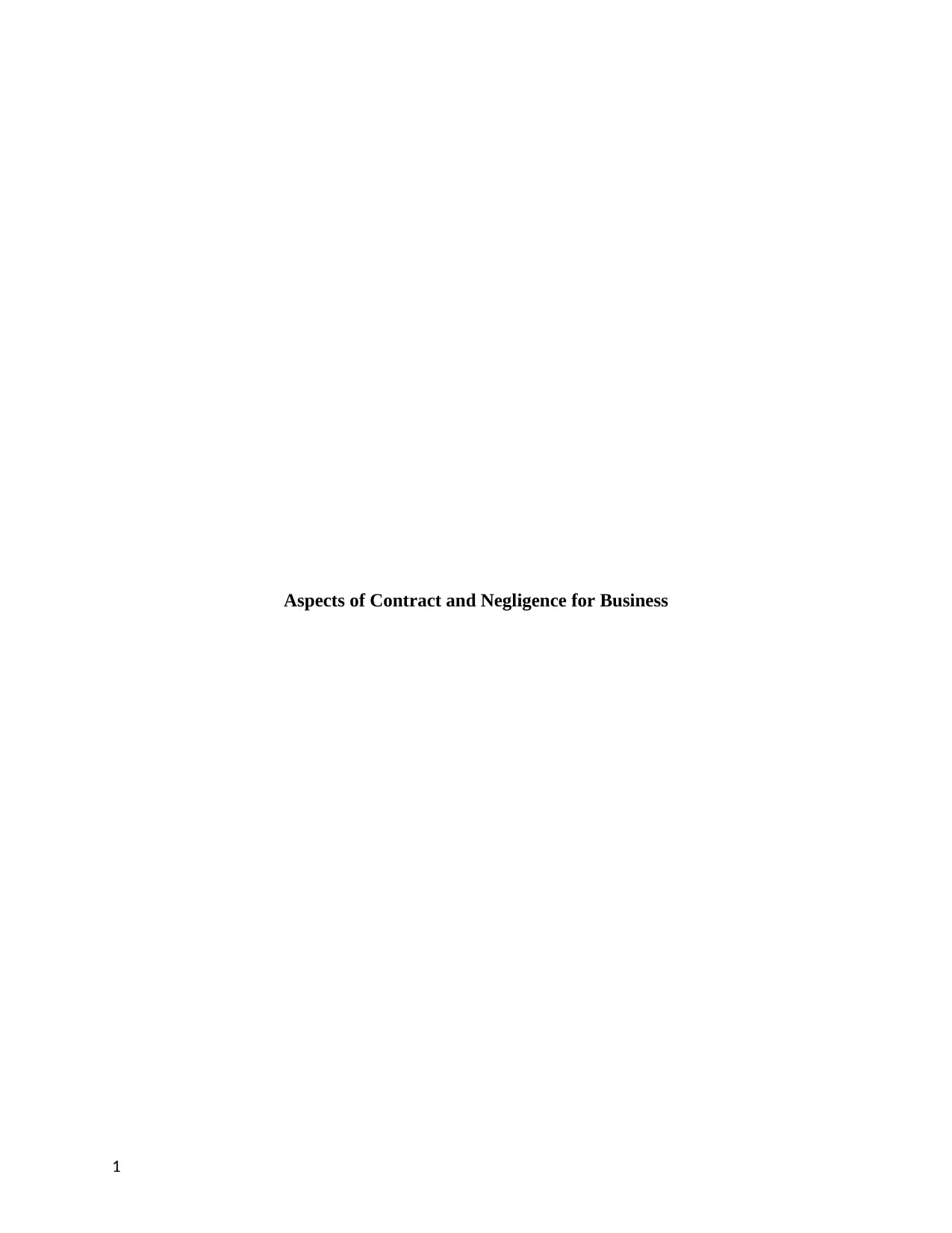
Aspects of Contract and Negligence for Business
1
1
Paraphrase This Document
Need a fresh take? Get an instant paraphrase of this document with our AI Paraphraser
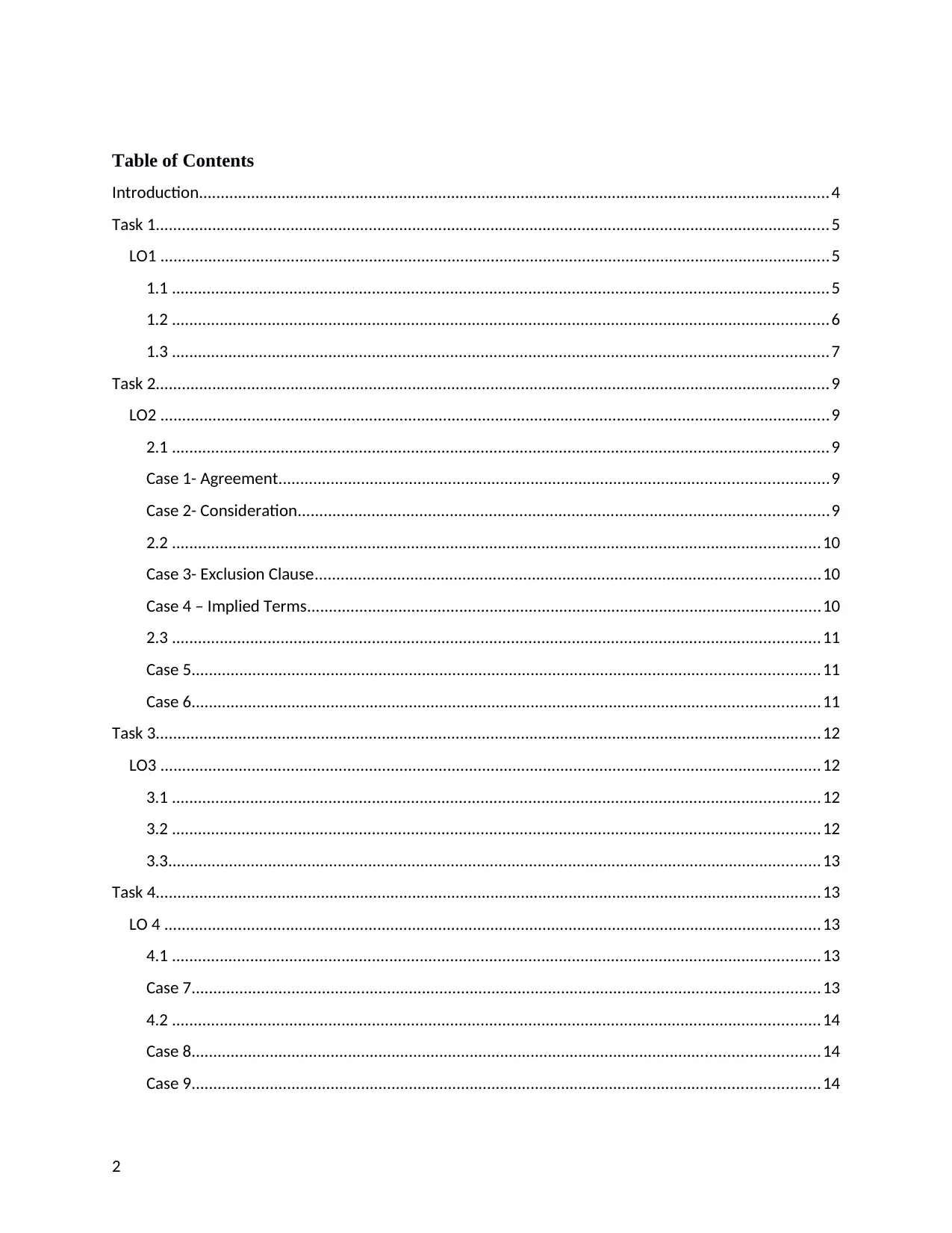
Table of Contents
Introduction.................................................................................................................................................4
Task 1...........................................................................................................................................................5
LO1 ..........................................................................................................................................................5
1.1 .......................................................................................................................................................5
1.2 .......................................................................................................................................................6
1.3 .......................................................................................................................................................7
Task 2...........................................................................................................................................................9
LO2 ..........................................................................................................................................................9
2.1 .......................................................................................................................................................9
Case 1- Agreement..............................................................................................................................9
Case 2- Consideration..........................................................................................................................9
2.2 .....................................................................................................................................................10
Case 3- Exclusion Clause....................................................................................................................10
Case 4 – Implied Terms......................................................................................................................10
2.3 .....................................................................................................................................................11
Case 5................................................................................................................................................11
Case 6................................................................................................................................................11
Task 3.........................................................................................................................................................12
LO3 ........................................................................................................................................................12
3.1 .....................................................................................................................................................12
3.2 .....................................................................................................................................................12
3.3......................................................................................................................................................13
Task 4.........................................................................................................................................................13
LO 4 .......................................................................................................................................................13
4.1 .....................................................................................................................................................13
Case 7................................................................................................................................................13
4.2 .....................................................................................................................................................14
Case 8................................................................................................................................................14
Case 9................................................................................................................................................14
2
Introduction.................................................................................................................................................4
Task 1...........................................................................................................................................................5
LO1 ..........................................................................................................................................................5
1.1 .......................................................................................................................................................5
1.2 .......................................................................................................................................................6
1.3 .......................................................................................................................................................7
Task 2...........................................................................................................................................................9
LO2 ..........................................................................................................................................................9
2.1 .......................................................................................................................................................9
Case 1- Agreement..............................................................................................................................9
Case 2- Consideration..........................................................................................................................9
2.2 .....................................................................................................................................................10
Case 3- Exclusion Clause....................................................................................................................10
Case 4 – Implied Terms......................................................................................................................10
2.3 .....................................................................................................................................................11
Case 5................................................................................................................................................11
Case 6................................................................................................................................................11
Task 3.........................................................................................................................................................12
LO3 ........................................................................................................................................................12
3.1 .....................................................................................................................................................12
3.2 .....................................................................................................................................................12
3.3......................................................................................................................................................13
Task 4.........................................................................................................................................................13
LO 4 .......................................................................................................................................................13
4.1 .....................................................................................................................................................13
Case 7................................................................................................................................................13
4.2 .....................................................................................................................................................14
Case 8................................................................................................................................................14
Case 9................................................................................................................................................14
2

References.................................................................................................................................................15
3
3
⊘ This is a preview!⊘
Do you want full access?
Subscribe today to unlock all pages.

Trusted by 1+ million students worldwide
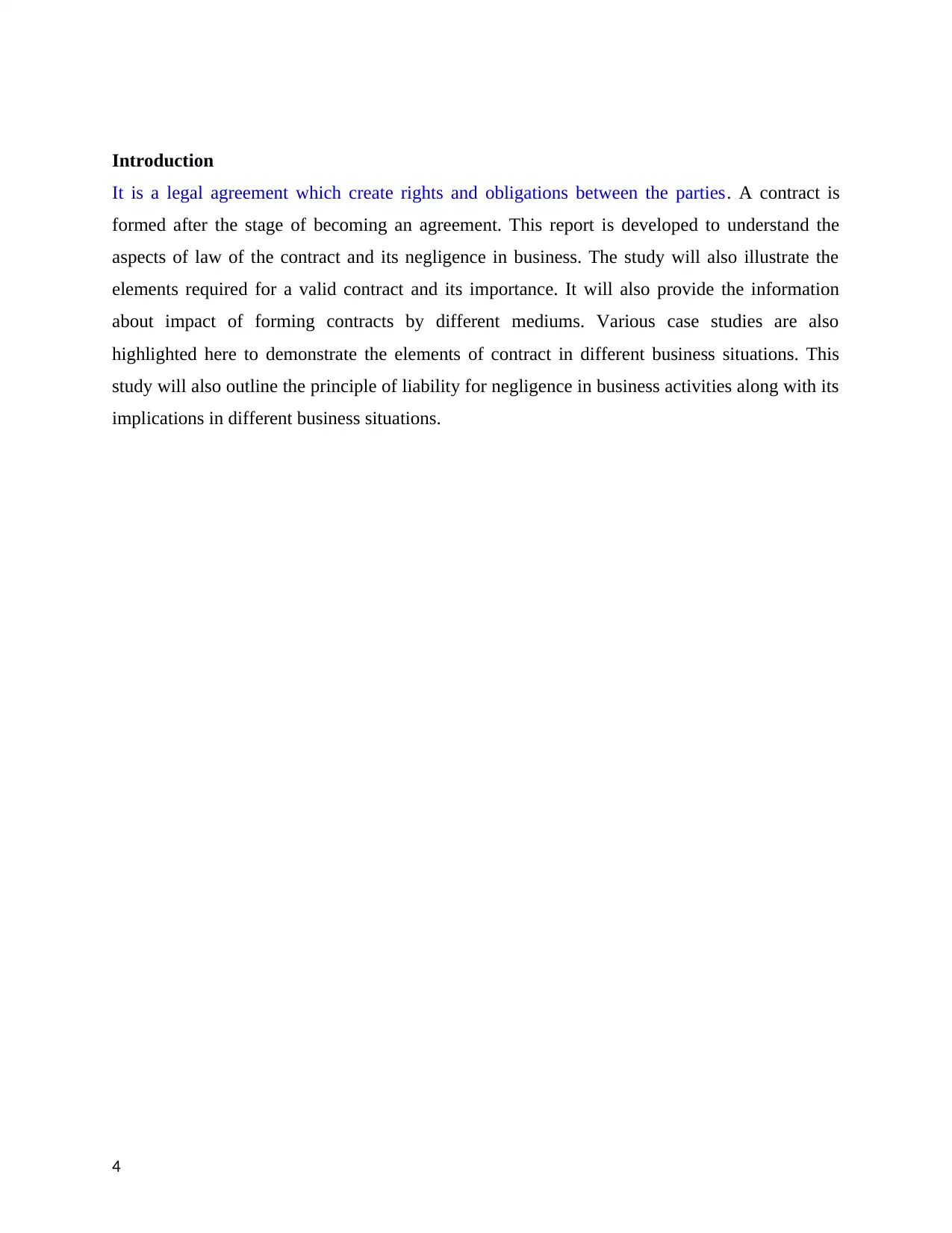
Introduction
It is a legal agreement which create rights and obligations between the parties. A contract is
formed after the stage of becoming an agreement. This report is developed to understand the
aspects of law of the contract and its negligence in business. The study will also illustrate the
elements required for a valid contract and its importance. It will also provide the information
about impact of forming contracts by different mediums. Various case studies are also
highlighted here to demonstrate the elements of contract in different business situations. This
study will also outline the principle of liability for negligence in business activities along with its
implications in different business situations.
4
It is a legal agreement which create rights and obligations between the parties. A contract is
formed after the stage of becoming an agreement. This report is developed to understand the
aspects of law of the contract and its negligence in business. The study will also illustrate the
elements required for a valid contract and its importance. It will also provide the information
about impact of forming contracts by different mediums. Various case studies are also
highlighted here to demonstrate the elements of contract in different business situations. This
study will also outline the principle of liability for negligence in business activities along with its
implications in different business situations.
4
Paraphrase This Document
Need a fresh take? Get an instant paraphrase of this document with our AI Paraphraser
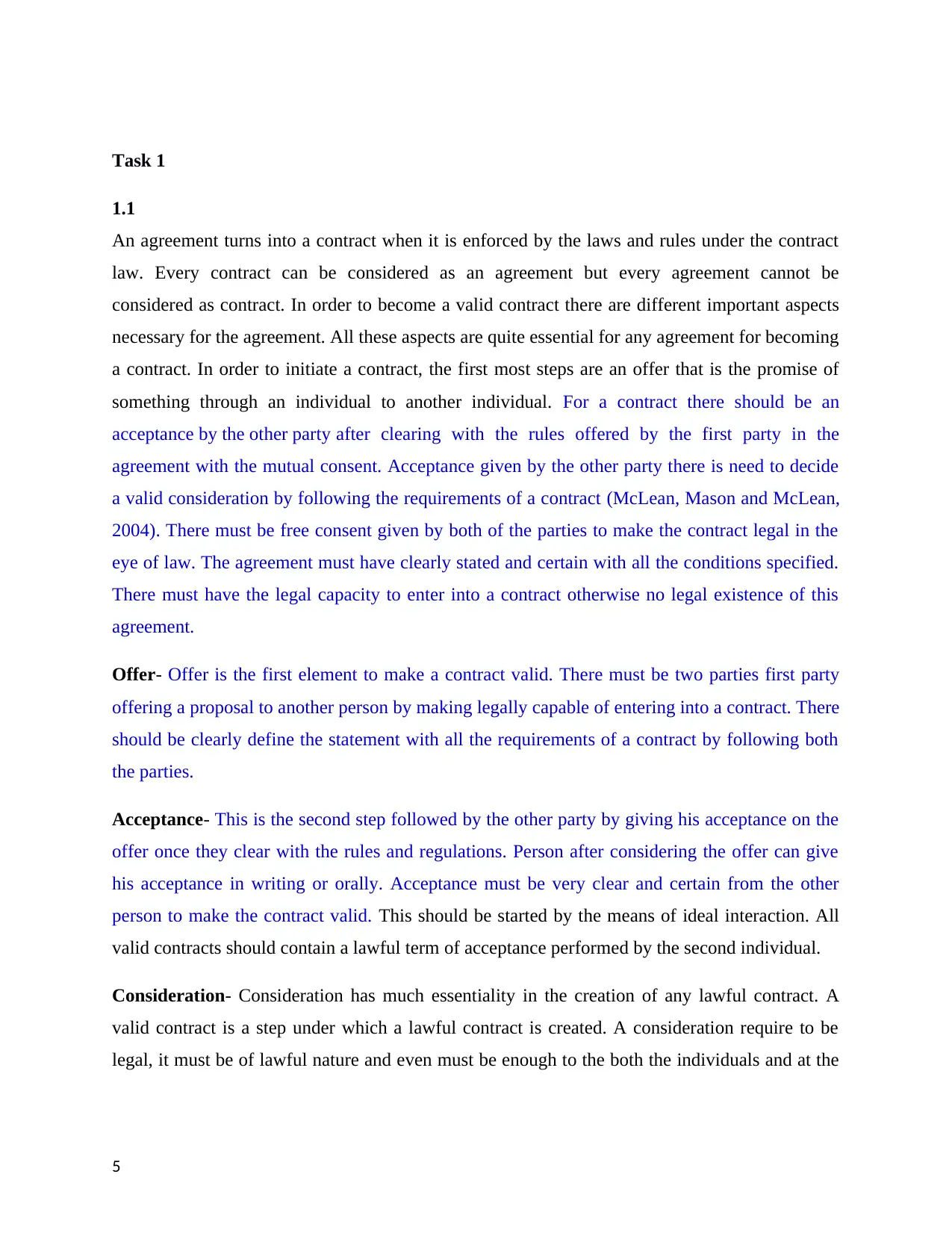
Task 1
1.1
An agreement turns into a contract when it is enforced by the laws and rules under the contract
law. Every contract can be considered as an agreement but every agreement cannot be
considered as contract. In order to become a valid contract there are different important aspects
necessary for the agreement. All these aspects are quite essential for any agreement for becoming
a contract. In order to initiate a contract, the first most steps are an offer that is the promise of
something through an individual to another individual. For a contract there should be an
acceptance by the other party after clearing with the rules offered by the first party in the
agreement with the mutual consent. Acceptance given by the other party there is need to decide
a valid consideration by following the requirements of a contract (McLean, Mason and McLean,
2004). There must be free consent given by both of the parties to make the contract legal in the
eye of law. The agreement must have clearly stated and certain with all the conditions specified.
There must have the legal capacity to enter into a contract otherwise no legal existence of this
agreement.
Offer- Offer is the first element to make a contract valid. There must be two parties first party
offering a proposal to another person by making legally capable of entering into a contract. There
should be clearly define the statement with all the requirements of a contract by following both
the parties.
Acceptance- This is the second step followed by the other party by giving his acceptance on the
offer once they clear with the rules and regulations. Person after considering the offer can give
his acceptance in writing or orally. Acceptance must be very clear and certain from the other
person to make the contract valid. This should be started by the means of ideal interaction. All
valid contracts should contain a lawful term of acceptance performed by the second individual.
Consideration- Consideration has much essentiality in the creation of any lawful contract. A
valid contract is a step under which a lawful contract is created. A consideration require to be
legal, it must be of lawful nature and even must be enough to the both the individuals and at the
5
1.1
An agreement turns into a contract when it is enforced by the laws and rules under the contract
law. Every contract can be considered as an agreement but every agreement cannot be
considered as contract. In order to become a valid contract there are different important aspects
necessary for the agreement. All these aspects are quite essential for any agreement for becoming
a contract. In order to initiate a contract, the first most steps are an offer that is the promise of
something through an individual to another individual. For a contract there should be an
acceptance by the other party after clearing with the rules offered by the first party in the
agreement with the mutual consent. Acceptance given by the other party there is need to decide
a valid consideration by following the requirements of a contract (McLean, Mason and McLean,
2004). There must be free consent given by both of the parties to make the contract legal in the
eye of law. The agreement must have clearly stated and certain with all the conditions specified.
There must have the legal capacity to enter into a contract otherwise no legal existence of this
agreement.
Offer- Offer is the first element to make a contract valid. There must be two parties first party
offering a proposal to another person by making legally capable of entering into a contract. There
should be clearly define the statement with all the requirements of a contract by following both
the parties.
Acceptance- This is the second step followed by the other party by giving his acceptance on the
offer once they clear with the rules and regulations. Person after considering the offer can give
his acceptance in writing or orally. Acceptance must be very clear and certain from the other
person to make the contract valid. This should be started by the means of ideal interaction. All
valid contracts should contain a lawful term of acceptance performed by the second individual.
Consideration- Consideration has much essentiality in the creation of any lawful contract. A
valid contract is a step under which a lawful contract is created. A consideration require to be
legal, it must be of lawful nature and even must be enough to the both the individuals and at the
5
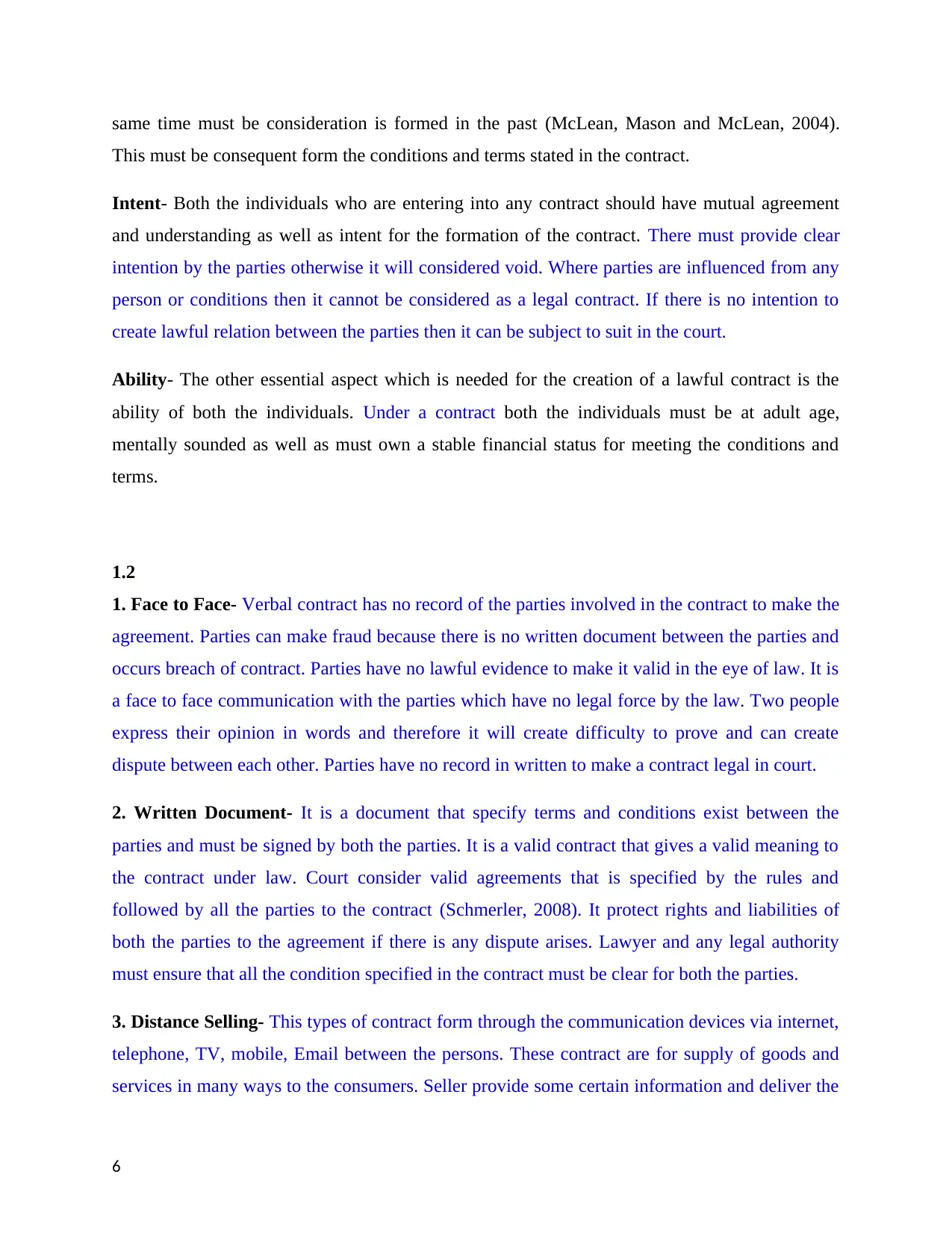
same time must be consideration is formed in the past (McLean, Mason and McLean, 2004).
This must be consequent form the conditions and terms stated in the contract.
Intent- Both the individuals who are entering into any contract should have mutual agreement
and understanding as well as intent for the formation of the contract. There must provide clear
intention by the parties otherwise it will considered void. Where parties are influenced from any
person or conditions then it cannot be considered as a legal contract. If there is no intention to
create lawful relation between the parties then it can be subject to suit in the court.
Ability- The other essential aspect which is needed for the creation of a lawful contract is the
ability of both the individuals. Under a contract both the individuals must be at adult age,
mentally sounded as well as must own a stable financial status for meeting the conditions and
terms.
1.2
1. Face to Face- Verbal contract has no record of the parties involved in the contract to make the
agreement. Parties can make fraud because there is no written document between the parties and
occurs breach of contract. Parties have no lawful evidence to make it valid in the eye of law. It is
a face to face communication with the parties which have no legal force by the law. Two people
express their opinion in words and therefore it will create difficulty to prove and can create
dispute between each other. Parties have no record in written to make a contract legal in court.
2. Written Document- It is a document that specify terms and conditions exist between the
parties and must be signed by both the parties. It is a valid contract that gives a valid meaning to
the contract under law. Court consider valid agreements that is specified by the rules and
followed by all the parties to the contract (Schmerler, 2008). It protect rights and liabilities of
both the parties to the agreement if there is any dispute arises. Lawyer and any legal authority
must ensure that all the condition specified in the contract must be clear for both the parties.
3. Distance Selling- This types of contract form through the communication devices via internet,
telephone, TV, mobile, Email between the persons. These contract are for supply of goods and
services in many ways to the consumers. Seller provide some certain information and deliver the
6
This must be consequent form the conditions and terms stated in the contract.
Intent- Both the individuals who are entering into any contract should have mutual agreement
and understanding as well as intent for the formation of the contract. There must provide clear
intention by the parties otherwise it will considered void. Where parties are influenced from any
person or conditions then it cannot be considered as a legal contract. If there is no intention to
create lawful relation between the parties then it can be subject to suit in the court.
Ability- The other essential aspect which is needed for the creation of a lawful contract is the
ability of both the individuals. Under a contract both the individuals must be at adult age,
mentally sounded as well as must own a stable financial status for meeting the conditions and
terms.
1.2
1. Face to Face- Verbal contract has no record of the parties involved in the contract to make the
agreement. Parties can make fraud because there is no written document between the parties and
occurs breach of contract. Parties have no lawful evidence to make it valid in the eye of law. It is
a face to face communication with the parties which have no legal force by the law. Two people
express their opinion in words and therefore it will create difficulty to prove and can create
dispute between each other. Parties have no record in written to make a contract legal in court.
2. Written Document- It is a document that specify terms and conditions exist between the
parties and must be signed by both the parties. It is a valid contract that gives a valid meaning to
the contract under law. Court consider valid agreements that is specified by the rules and
followed by all the parties to the contract (Schmerler, 2008). It protect rights and liabilities of
both the parties to the agreement if there is any dispute arises. Lawyer and any legal authority
must ensure that all the condition specified in the contract must be clear for both the parties.
3. Distance Selling- This types of contract form through the communication devices via internet,
telephone, TV, mobile, Email between the persons. These contract are for supply of goods and
services in many ways to the consumers. Seller provide some certain information and deliver the
6
⊘ This is a preview!⊘
Do you want full access?
Subscribe today to unlock all pages.

Trusted by 1+ million students worldwide
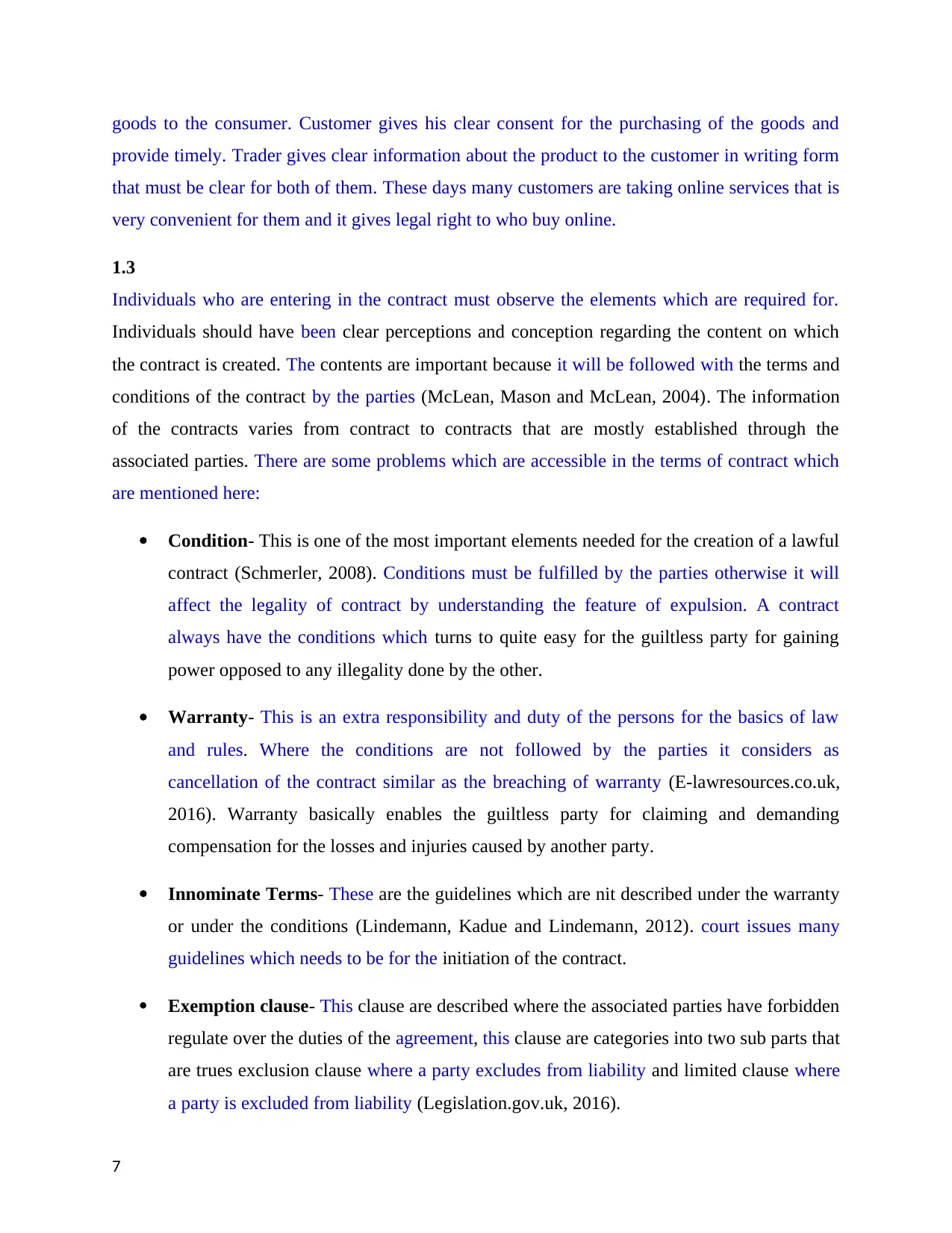
goods to the consumer. Customer gives his clear consent for the purchasing of the goods and
provide timely. Trader gives clear information about the product to the customer in writing form
that must be clear for both of them. These days many customers are taking online services that is
very convenient for them and it gives legal right to who buy online.
1.3
Individuals who are entering in the contract must observe the elements which are required for.
Individuals should have been clear perceptions and conception regarding the content on which
the contract is created. The contents are important because it will be followed with the terms and
conditions of the contract by the parties (McLean, Mason and McLean, 2004). The information
of the contracts varies from contract to contracts that are mostly established through the
associated parties. There are some problems which are accessible in the terms of contract which
are mentioned here:
Condition- This is one of the most important elements needed for the creation of a lawful
contract (Schmerler, 2008). Conditions must be fulfilled by the parties otherwise it will
affect the legality of contract by understanding the feature of expulsion. A contract
always have the conditions which turns to quite easy for the guiltless party for gaining
power opposed to any illegality done by the other.
Warranty- This is an extra responsibility and duty of the persons for the basics of law
and rules. Where the conditions are not followed by the parties it considers as
cancellation of the contract similar as the breaching of warranty (E-lawresources.co.uk,
2016). Warranty basically enables the guiltless party for claiming and demanding
compensation for the losses and injuries caused by another party.
Innominate Terms- These are the guidelines which are nit described under the warranty
or under the conditions (Lindemann, Kadue and Lindemann, 2012). court issues many
guidelines which needs to be for the initiation of the contract.
Exemption clause- This clause are described where the associated parties have forbidden
regulate over the duties of the agreement, this clause are categories into two sub parts that
are trues exclusion clause where a party excludes from liability and limited clause where
a party is excluded from liability (Legislation.gov.uk, 2016).
7
provide timely. Trader gives clear information about the product to the customer in writing form
that must be clear for both of them. These days many customers are taking online services that is
very convenient for them and it gives legal right to who buy online.
1.3
Individuals who are entering in the contract must observe the elements which are required for.
Individuals should have been clear perceptions and conception regarding the content on which
the contract is created. The contents are important because it will be followed with the terms and
conditions of the contract by the parties (McLean, Mason and McLean, 2004). The information
of the contracts varies from contract to contracts that are mostly established through the
associated parties. There are some problems which are accessible in the terms of contract which
are mentioned here:
Condition- This is one of the most important elements needed for the creation of a lawful
contract (Schmerler, 2008). Conditions must be fulfilled by the parties otherwise it will
affect the legality of contract by understanding the feature of expulsion. A contract
always have the conditions which turns to quite easy for the guiltless party for gaining
power opposed to any illegality done by the other.
Warranty- This is an extra responsibility and duty of the persons for the basics of law
and rules. Where the conditions are not followed by the parties it considers as
cancellation of the contract similar as the breaching of warranty (E-lawresources.co.uk,
2016). Warranty basically enables the guiltless party for claiming and demanding
compensation for the losses and injuries caused by another party.
Innominate Terms- These are the guidelines which are nit described under the warranty
or under the conditions (Lindemann, Kadue and Lindemann, 2012). court issues many
guidelines which needs to be for the initiation of the contract.
Exemption clause- This clause are described where the associated parties have forbidden
regulate over the duties of the agreement, this clause are categories into two sub parts that
are trues exclusion clause where a party excludes from liability and limited clause where
a party is excluded from liability (Legislation.gov.uk, 2016).
7
Paraphrase This Document
Need a fresh take? Get an instant paraphrase of this document with our AI Paraphraser
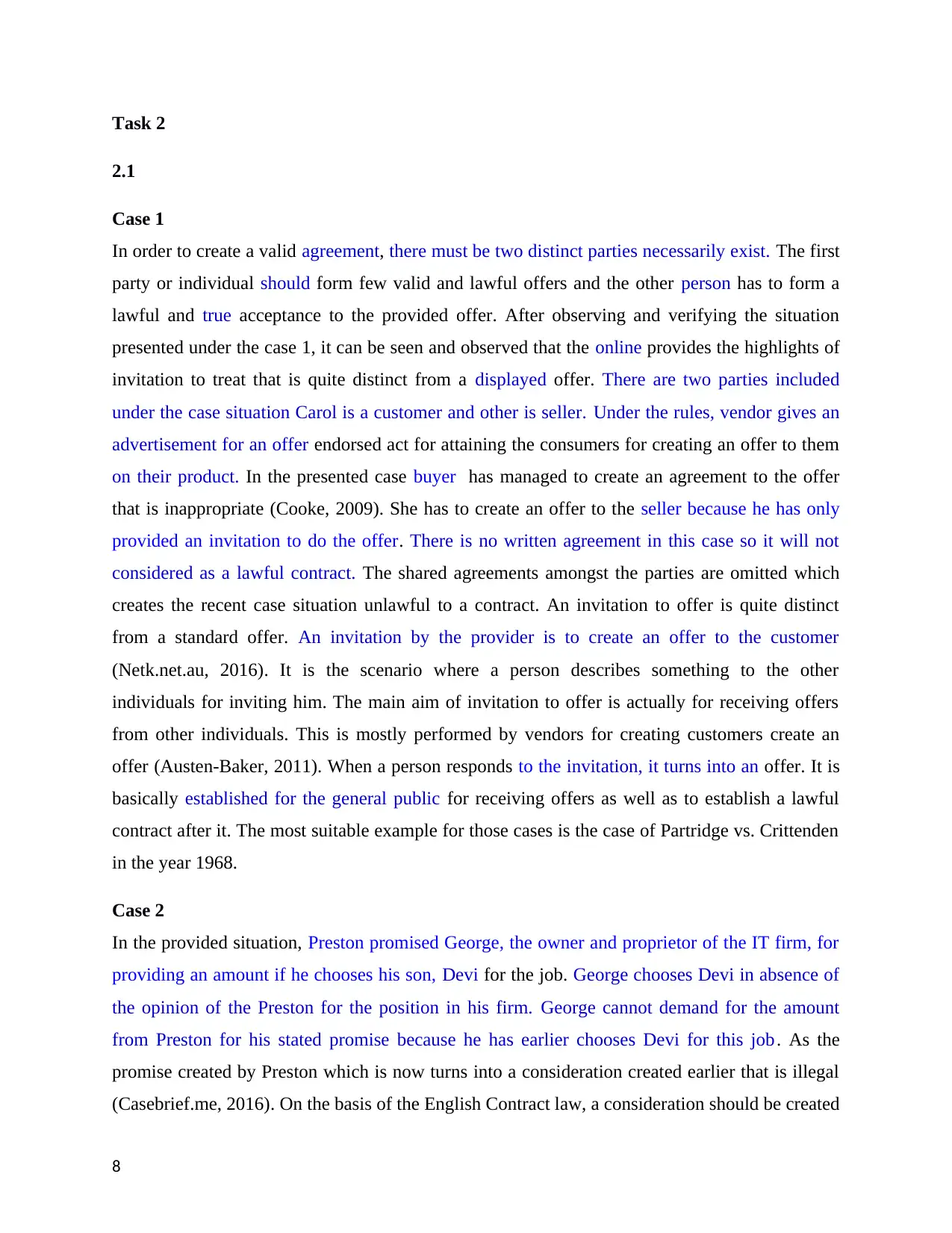
Task 2
2.1
Case 1
In order to create a valid agreement, there must be two distinct parties necessarily exist. The first
party or individual should form few valid and lawful offers and the other person has to form a
lawful and true acceptance to the provided offer. After observing and verifying the situation
presented under the case 1, it can be seen and observed that the online provides the highlights of
invitation to treat that is quite distinct from a displayed offer. There are two parties included
under the case situation Carol is a customer and other is seller. Under the rules, vendor gives an
advertisement for an offer endorsed act for attaining the consumers for creating an offer to them
on their product. In the presented case buyer has managed to create an agreement to the offer
that is inappropriate (Cooke, 2009). She has to create an offer to the seller because he has only
provided an invitation to do the offer. There is no written agreement in this case so it will not
considered as a lawful contract. The shared agreements amongst the parties are omitted which
creates the recent case situation unlawful to a contract. An invitation to offer is quite distinct
from a standard offer. An invitation by the provider is to create an offer to the customer
(Netk.net.au, 2016). It is the scenario where a person describes something to the other
individuals for inviting him. The main aim of invitation to offer is actually for receiving offers
from other individuals. This is mostly performed by vendors for creating customers create an
offer (Austen-Baker, 2011). When a person responds to the invitation, it turns into an offer. It is
basically established for the general public for receiving offers as well as to establish a lawful
contract after it. The most suitable example for those cases is the case of Partridge vs. Crittenden
in the year 1968.
Case 2
In the provided situation, Preston promised George, the owner and proprietor of the IT firm, for
providing an amount if he chooses his son, Devi for the job. George chooses Devi in absence of
the opinion of the Preston for the position in his firm. George cannot demand for the amount
from Preston for his stated promise because he has earlier chooses Devi for this job. As the
promise created by Preston which is now turns into a consideration created earlier that is illegal
(Casebrief.me, 2016). On the basis of the English Contract law, a consideration should be created
8
2.1
Case 1
In order to create a valid agreement, there must be two distinct parties necessarily exist. The first
party or individual should form few valid and lawful offers and the other person has to form a
lawful and true acceptance to the provided offer. After observing and verifying the situation
presented under the case 1, it can be seen and observed that the online provides the highlights of
invitation to treat that is quite distinct from a displayed offer. There are two parties included
under the case situation Carol is a customer and other is seller. Under the rules, vendor gives an
advertisement for an offer endorsed act for attaining the consumers for creating an offer to them
on their product. In the presented case buyer has managed to create an agreement to the offer
that is inappropriate (Cooke, 2009). She has to create an offer to the seller because he has only
provided an invitation to do the offer. There is no written agreement in this case so it will not
considered as a lawful contract. The shared agreements amongst the parties are omitted which
creates the recent case situation unlawful to a contract. An invitation to offer is quite distinct
from a standard offer. An invitation by the provider is to create an offer to the customer
(Netk.net.au, 2016). It is the scenario where a person describes something to the other
individuals for inviting him. The main aim of invitation to offer is actually for receiving offers
from other individuals. This is mostly performed by vendors for creating customers create an
offer (Austen-Baker, 2011). When a person responds to the invitation, it turns into an offer. It is
basically established for the general public for receiving offers as well as to establish a lawful
contract after it. The most suitable example for those cases is the case of Partridge vs. Crittenden
in the year 1968.
Case 2
In the provided situation, Preston promised George, the owner and proprietor of the IT firm, for
providing an amount if he chooses his son, Devi for the job. George chooses Devi in absence of
the opinion of the Preston for the position in his firm. George cannot demand for the amount
from Preston for his stated promise because he has earlier chooses Devi for this job. As the
promise created by Preston which is now turns into a consideration created earlier that is illegal
(Casebrief.me, 2016). On the basis of the English Contract law, a consideration should be created
8
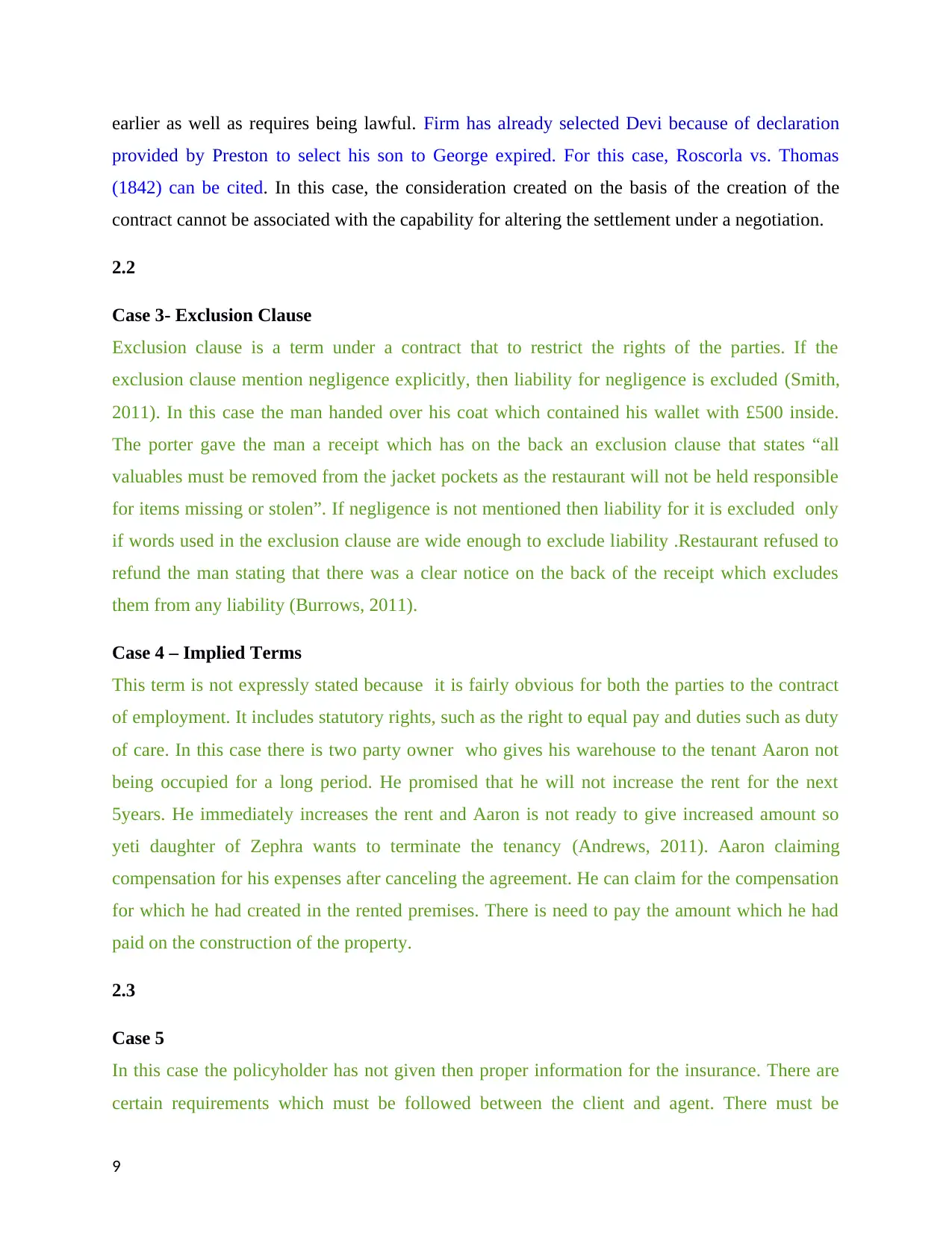
earlier as well as requires being lawful. Firm has already selected Devi because of declaration
provided by Preston to select his son to George expired. For this case, Roscorla vs. Thomas
(1842) can be cited. In this case, the consideration created on the basis of the creation of the
contract cannot be associated with the capability for altering the settlement under a negotiation.
2.2
Case 3- Exclusion Clause
Exclusion clause is a term under a contract that to restrict the rights of the parties. If the
exclusion clause mention negligence explicitly, then liability for negligence is excluded (Smith,
2011). In this case the man handed over his coat which contained his wallet with £500 inside.
The porter gave the man a receipt which has on the back an exclusion clause that states “all
valuables must be removed from the jacket pockets as the restaurant will not be held responsible
for items missing or stolen”. If negligence is not mentioned then liability for it is excluded only
if words used in the exclusion clause are wide enough to exclude liability .Restaurant refused to
refund the man stating that there was a clear notice on the back of the receipt which excludes
them from any liability (Burrows, 2011).
Case 4 – Implied Terms
This term is not expressly stated because it is fairly obvious for both the parties to the contract
of employment. It includes statutory rights, such as the right to equal pay and duties such as duty
of care. In this case there is two party owner who gives his warehouse to the tenant Aaron not
being occupied for a long period. He promised that he will not increase the rent for the next
5years. He immediately increases the rent and Aaron is not ready to give increased amount so
yeti daughter of Zephra wants to terminate the tenancy (Andrews, 2011). Aaron claiming
compensation for his expenses after canceling the agreement. He can claim for the compensation
for which he had created in the rented premises. There is need to pay the amount which he had
paid on the construction of the property.
2.3
Case 5
In this case the policyholder has not given then proper information for the insurance. There are
certain requirements which must be followed between the client and agent. There must be
9
provided by Preston to select his son to George expired. For this case, Roscorla vs. Thomas
(1842) can be cited. In this case, the consideration created on the basis of the creation of the
contract cannot be associated with the capability for altering the settlement under a negotiation.
2.2
Case 3- Exclusion Clause
Exclusion clause is a term under a contract that to restrict the rights of the parties. If the
exclusion clause mention negligence explicitly, then liability for negligence is excluded (Smith,
2011). In this case the man handed over his coat which contained his wallet with £500 inside.
The porter gave the man a receipt which has on the back an exclusion clause that states “all
valuables must be removed from the jacket pockets as the restaurant will not be held responsible
for items missing or stolen”. If negligence is not mentioned then liability for it is excluded only
if words used in the exclusion clause are wide enough to exclude liability .Restaurant refused to
refund the man stating that there was a clear notice on the back of the receipt which excludes
them from any liability (Burrows, 2011).
Case 4 – Implied Terms
This term is not expressly stated because it is fairly obvious for both the parties to the contract
of employment. It includes statutory rights, such as the right to equal pay and duties such as duty
of care. In this case there is two party owner who gives his warehouse to the tenant Aaron not
being occupied for a long period. He promised that he will not increase the rent for the next
5years. He immediately increases the rent and Aaron is not ready to give increased amount so
yeti daughter of Zephra wants to terminate the tenancy (Andrews, 2011). Aaron claiming
compensation for his expenses after canceling the agreement. He can claim for the compensation
for which he had created in the rented premises. There is need to pay the amount which he had
paid on the construction of the property.
2.3
Case 5
In this case the policyholder has not given then proper information for the insurance. There are
certain requirements which must be followed between the client and agent. There must be
9
⊘ This is a preview!⊘
Do you want full access?
Subscribe today to unlock all pages.

Trusted by 1+ million students worldwide
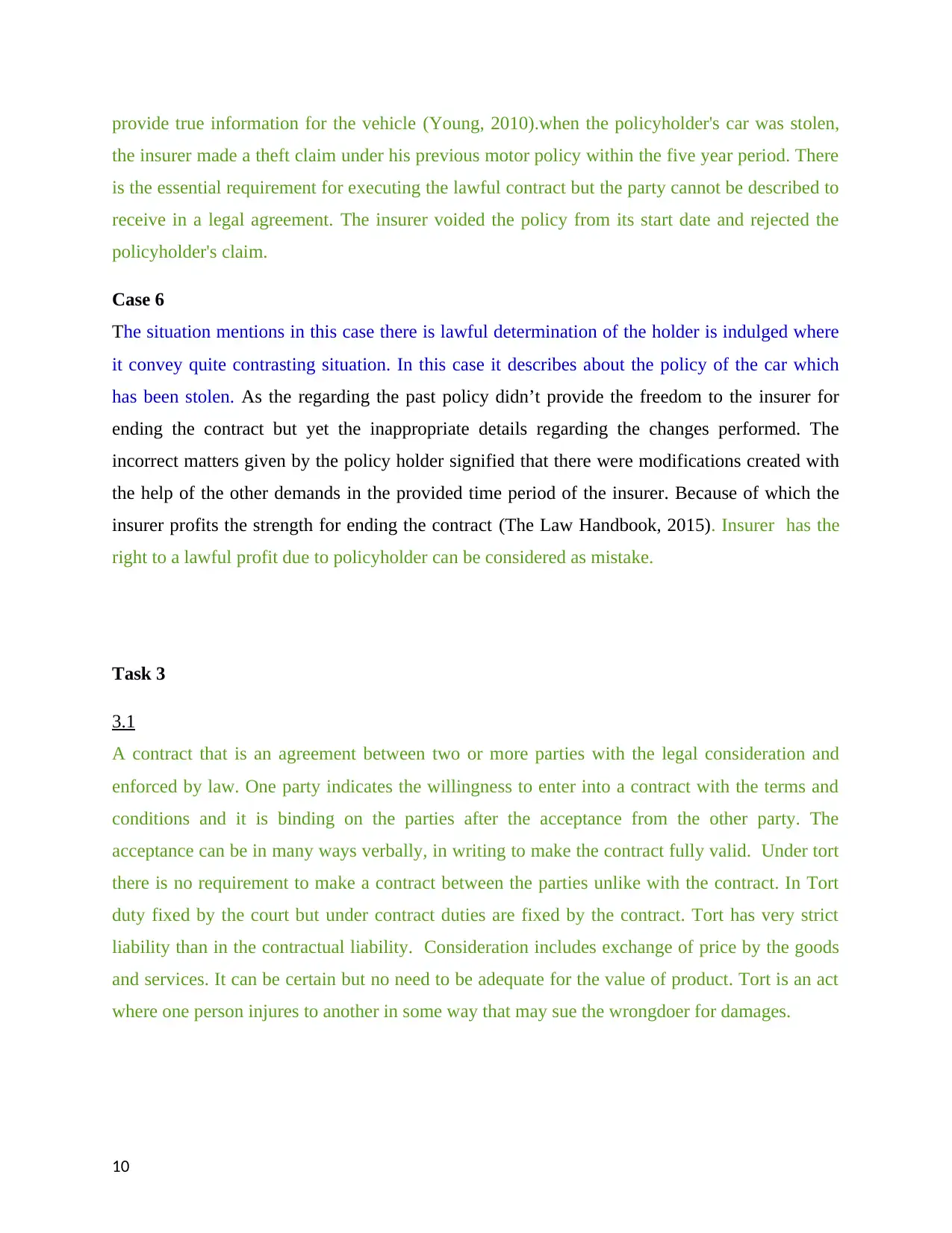
provide true information for the vehicle (Young, 2010).when the policyholder's car was stolen,
the insurer made a theft claim under his previous motor policy within the five year period. There
is the essential requirement for executing the lawful contract but the party cannot be described to
receive in a legal agreement. The insurer voided the policy from its start date and rejected the
policyholder's claim.
Case 6
The situation mentions in this case there is lawful determination of the holder is indulged where
it convey quite contrasting situation. In this case it describes about the policy of the car which
has been stolen. As the regarding the past policy didn’t provide the freedom to the insurer for
ending the contract but yet the inappropriate details regarding the changes performed. The
incorrect matters given by the policy holder signified that there were modifications created with
the help of the other demands in the provided time period of the insurer. Because of which the
insurer profits the strength for ending the contract (The Law Handbook, 2015). Insurer has the
right to a lawful profit due to policyholder can be considered as mistake.
Task 3
3.1
A contract that is an agreement between two or more parties with the legal consideration and
enforced by law. One party indicates the willingness to enter into a contract with the terms and
conditions and it is binding on the parties after the acceptance from the other party. The
acceptance can be in many ways verbally, in writing to make the contract fully valid. Under tort
there is no requirement to make a contract between the parties unlike with the contract. In Tort
duty fixed by the court but under contract duties are fixed by the contract. Tort has very strict
liability than in the contractual liability. Consideration includes exchange of price by the goods
and services. It can be certain but no need to be adequate for the value of product. Tort is an act
where one person injures to another in some way that may sue the wrongdoer for damages.
10
the insurer made a theft claim under his previous motor policy within the five year period. There
is the essential requirement for executing the lawful contract but the party cannot be described to
receive in a legal agreement. The insurer voided the policy from its start date and rejected the
policyholder's claim.
Case 6
The situation mentions in this case there is lawful determination of the holder is indulged where
it convey quite contrasting situation. In this case it describes about the policy of the car which
has been stolen. As the regarding the past policy didn’t provide the freedom to the insurer for
ending the contract but yet the inappropriate details regarding the changes performed. The
incorrect matters given by the policy holder signified that there were modifications created with
the help of the other demands in the provided time period of the insurer. Because of which the
insurer profits the strength for ending the contract (The Law Handbook, 2015). Insurer has the
right to a lawful profit due to policyholder can be considered as mistake.
Task 3
3.1
A contract that is an agreement between two or more parties with the legal consideration and
enforced by law. One party indicates the willingness to enter into a contract with the terms and
conditions and it is binding on the parties after the acceptance from the other party. The
acceptance can be in many ways verbally, in writing to make the contract fully valid. Under tort
there is no requirement to make a contract between the parties unlike with the contract. In Tort
duty fixed by the court but under contract duties are fixed by the contract. Tort has very strict
liability than in the contractual liability. Consideration includes exchange of price by the goods
and services. It can be certain but no need to be adequate for the value of product. Tort is an act
where one person injures to another in some way that may sue the wrongdoer for damages.
10
Paraphrase This Document
Need a fresh take? Get an instant paraphrase of this document with our AI Paraphraser
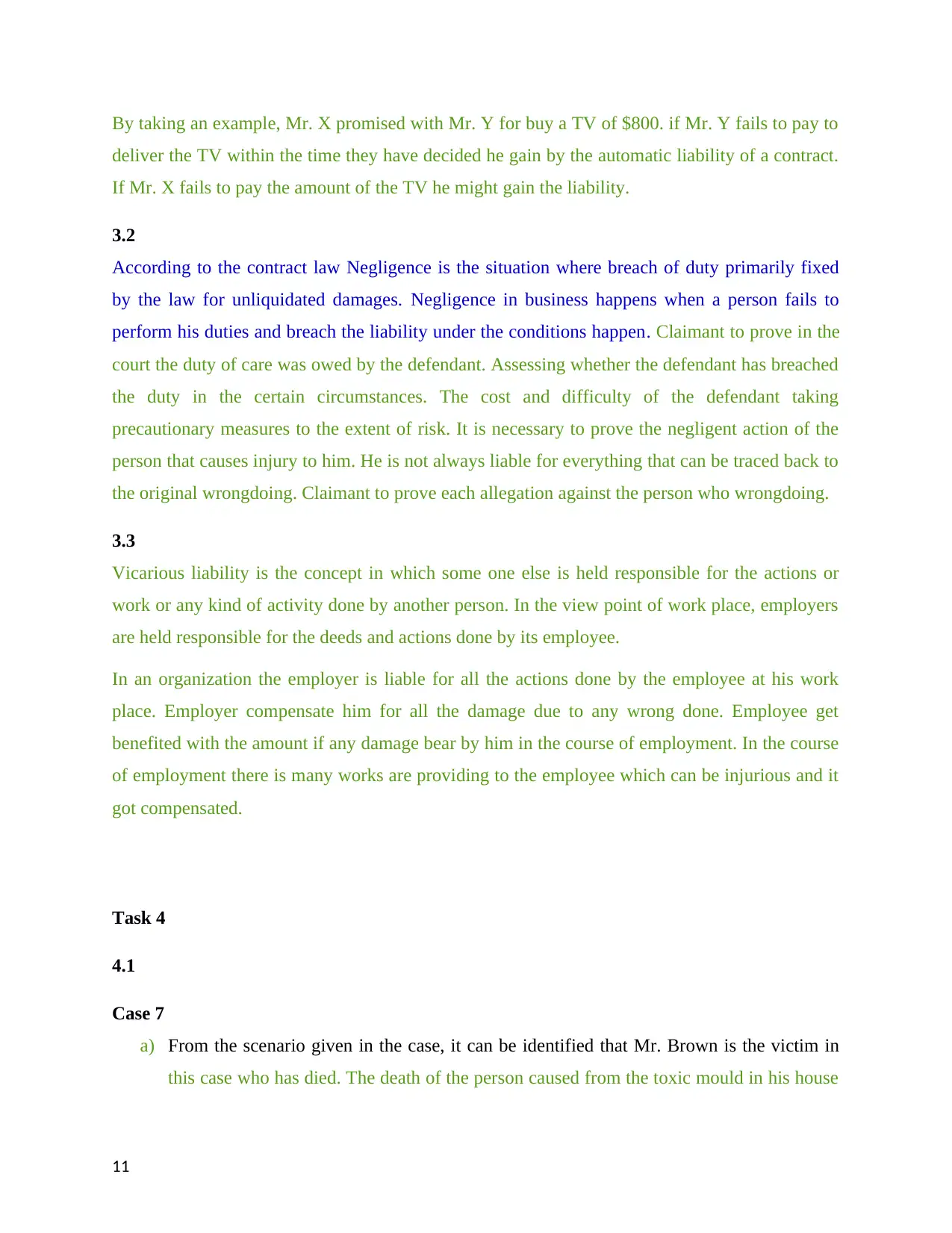
By taking an example, Mr. X promised with Mr. Y for buy a TV of $800. if Mr. Y fails to pay to
deliver the TV within the time they have decided he gain by the automatic liability of a contract.
If Mr. X fails to pay the amount of the TV he might gain the liability.
3.2
According to the contract law Negligence is the situation where breach of duty primarily fixed
by the law for unliquidated damages. Negligence in business happens when a person fails to
perform his duties and breach the liability under the conditions happen. Claimant to prove in the
court the duty of care was owed by the defendant. Assessing whether the defendant has breached
the duty in the certain circumstances. The cost and difficulty of the defendant taking
precautionary measures to the extent of risk. It is necessary to prove the negligent action of the
person that causes injury to him. He is not always liable for everything that can be traced back to
the original wrongdoing. Claimant to prove each allegation against the person who wrongdoing.
3.3
Vicarious liability is the concept in which some one else is held responsible for the actions or
work or any kind of activity done by another person. In the view point of work place, employers
are held responsible for the deeds and actions done by its employee.
In an organization the employer is liable for all the actions done by the employee at his work
place. Employer compensate him for all the damage due to any wrong done. Employee get
benefited with the amount if any damage bear by him in the course of employment. In the course
of employment there is many works are providing to the employee which can be injurious and it
got compensated.
Task 4
4.1
Case 7
a) From the scenario given in the case, it can be identified that Mr. Brown is the victim in
this case who has died. The death of the person caused from the toxic mould in his house
11
deliver the TV within the time they have decided he gain by the automatic liability of a contract.
If Mr. X fails to pay the amount of the TV he might gain the liability.
3.2
According to the contract law Negligence is the situation where breach of duty primarily fixed
by the law for unliquidated damages. Negligence in business happens when a person fails to
perform his duties and breach the liability under the conditions happen. Claimant to prove in the
court the duty of care was owed by the defendant. Assessing whether the defendant has breached
the duty in the certain circumstances. The cost and difficulty of the defendant taking
precautionary measures to the extent of risk. It is necessary to prove the negligent action of the
person that causes injury to him. He is not always liable for everything that can be traced back to
the original wrongdoing. Claimant to prove each allegation against the person who wrongdoing.
3.3
Vicarious liability is the concept in which some one else is held responsible for the actions or
work or any kind of activity done by another person. In the view point of work place, employers
are held responsible for the deeds and actions done by its employee.
In an organization the employer is liable for all the actions done by the employee at his work
place. Employer compensate him for all the damage due to any wrong done. Employee get
benefited with the amount if any damage bear by him in the course of employment. In the course
of employment there is many works are providing to the employee which can be injurious and it
got compensated.
Task 4
4.1
Case 7
a) From the scenario given in the case, it can be identified that Mr. Brown is the victim in
this case who has died. The death of the person caused from the toxic mould in his house
11
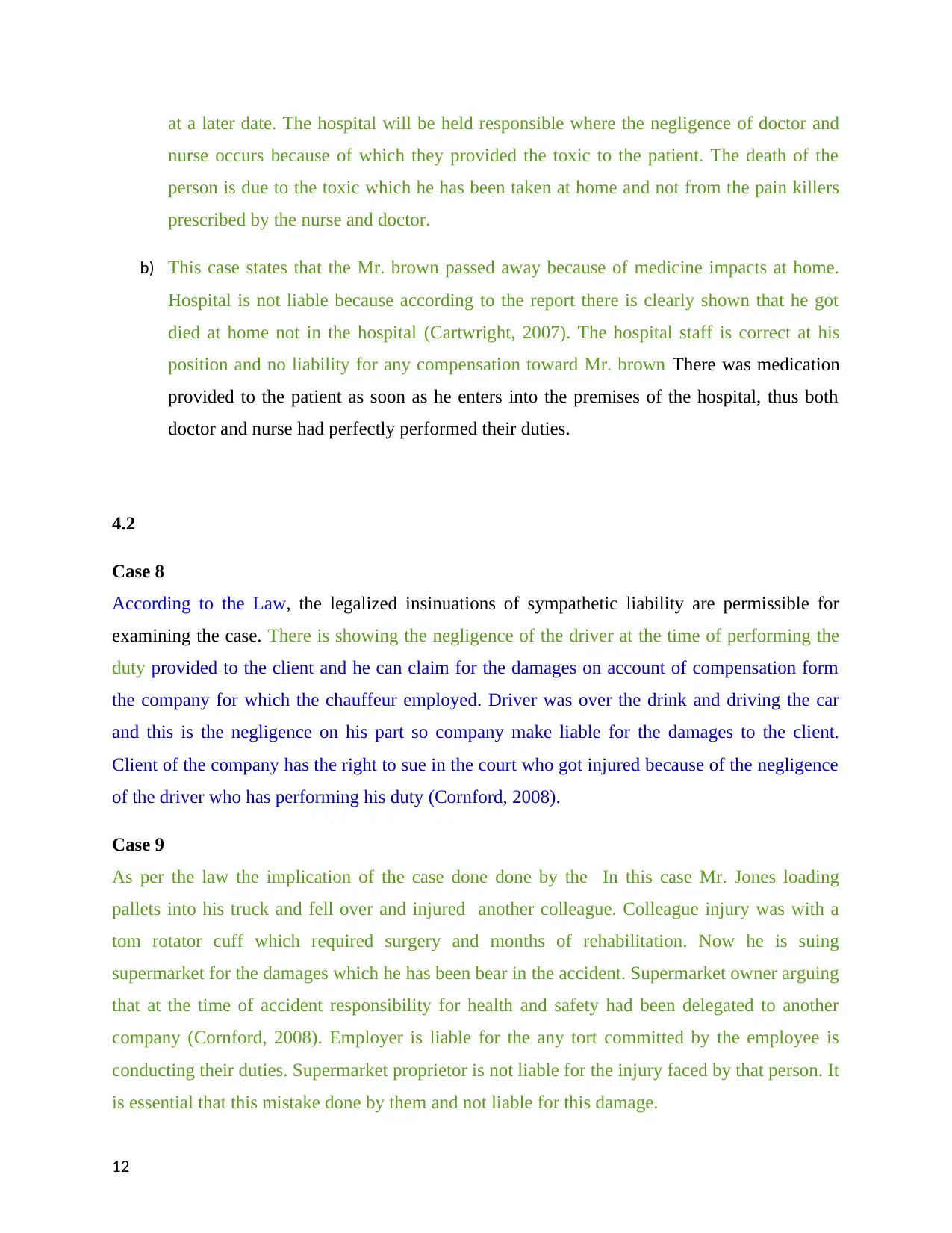
at a later date. The hospital will be held responsible where the negligence of doctor and
nurse occurs because of which they provided the toxic to the patient. The death of the
person is due to the toxic which he has been taken at home and not from the pain killers
prescribed by the nurse and doctor.
b) This case states that the Mr. brown passed away because of medicine impacts at home.
Hospital is not liable because according to the report there is clearly shown that he got
died at home not in the hospital (Cartwright, 2007). The hospital staff is correct at his
position and no liability for any compensation toward Mr. brown There was medication
provided to the patient as soon as he enters into the premises of the hospital, thus both
doctor and nurse had perfectly performed their duties.
4.2
Case 8
According to the Law, the legalized insinuations of sympathetic liability are permissible for
examining the case. There is showing the negligence of the driver at the time of performing the
duty provided to the client and he can claim for the damages on account of compensation form
the company for which the chauffeur employed. Driver was over the drink and driving the car
and this is the negligence on his part so company make liable for the damages to the client.
Client of the company has the right to sue in the court who got injured because of the negligence
of the driver who has performing his duty (Cornford, 2008).
Case 9
As per the law the implication of the case done done by the In this case Mr. Jones loading
pallets into his truck and fell over and injured another colleague. Colleague injury was with a
tom rotator cuff which required surgery and months of rehabilitation. Now he is suing
supermarket for the damages which he has been bear in the accident. Supermarket owner arguing
that at the time of accident responsibility for health and safety had been delegated to another
company (Cornford, 2008). Employer is liable for the any tort committed by the employee is
conducting their duties. Supermarket proprietor is not liable for the injury faced by that person. It
is essential that this mistake done by them and not liable for this damage.
12
nurse occurs because of which they provided the toxic to the patient. The death of the
person is due to the toxic which he has been taken at home and not from the pain killers
prescribed by the nurse and doctor.
b) This case states that the Mr. brown passed away because of medicine impacts at home.
Hospital is not liable because according to the report there is clearly shown that he got
died at home not in the hospital (Cartwright, 2007). The hospital staff is correct at his
position and no liability for any compensation toward Mr. brown There was medication
provided to the patient as soon as he enters into the premises of the hospital, thus both
doctor and nurse had perfectly performed their duties.
4.2
Case 8
According to the Law, the legalized insinuations of sympathetic liability are permissible for
examining the case. There is showing the negligence of the driver at the time of performing the
duty provided to the client and he can claim for the damages on account of compensation form
the company for which the chauffeur employed. Driver was over the drink and driving the car
and this is the negligence on his part so company make liable for the damages to the client.
Client of the company has the right to sue in the court who got injured because of the negligence
of the driver who has performing his duty (Cornford, 2008).
Case 9
As per the law the implication of the case done done by the In this case Mr. Jones loading
pallets into his truck and fell over and injured another colleague. Colleague injury was with a
tom rotator cuff which required surgery and months of rehabilitation. Now he is suing
supermarket for the damages which he has been bear in the accident. Supermarket owner arguing
that at the time of accident responsibility for health and safety had been delegated to another
company (Cornford, 2008). Employer is liable for the any tort committed by the employee is
conducting their duties. Supermarket proprietor is not liable for the injury faced by that person. It
is essential that this mistake done by them and not liable for this damage.
12
⊘ This is a preview!⊘
Do you want full access?
Subscribe today to unlock all pages.

Trusted by 1+ million students worldwide
1 out of 15
Related Documents
Your All-in-One AI-Powered Toolkit for Academic Success.
+13062052269
info@desklib.com
Available 24*7 on WhatsApp / Email
![[object Object]](/_next/static/media/star-bottom.7253800d.svg)
Unlock your academic potential
Copyright © 2020–2025 A2Z Services. All Rights Reserved. Developed and managed by ZUCOL.





